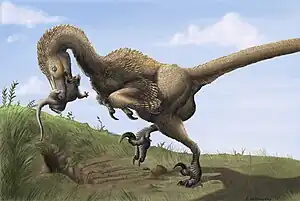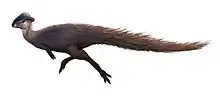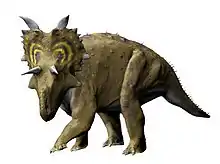| Foremost Formation | |
|---|---|
| Stratigraphic range: Campanian, | |
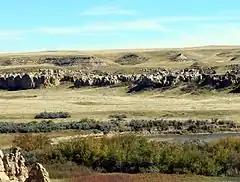 Outcrops of the Foremost Formation (basal sandstone and MacKay coal zone) along the Milk River at Writing-On-Stone Provincial Park | |
| Type | Geological formation |
| Unit of | Belly River Group (Judith River Group) |
| Underlies | Oldman Formation |
| Overlies | Pakowki Formation |
| Thickness | up to 170 metres (560 ft) |
| Lithology | |
| Primary | Sandstone, siltstone, mudstone |
| Other | Shale, coal |
| Location | |
| Region | |
| Country | |
| Type section | |
| Named for | Foremost, Alberta[1] |
| Named by | D.B. Dowling, 1915[2] |
The Foremost Formation is a stratigraphic unit of Late Cretaceous (Campanian) age that underlies much of southern Alberta, Canada. It was named for outcrops in Chin Coulee near the town of Foremost[1] and is known primarily for its dinosaur remains and other fossils.[3]
Geology
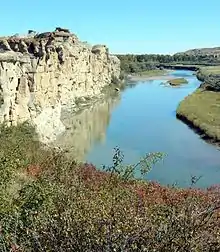
The Foremost Formation is the basal unit of the Belly River Group (called the Judith River Group in the United States). It gradationally overlies the marine shales of the Pakowki Formation. It consists of sediments that were eroded from the mountains to the west and carried northeastward by river systems, where they gradually prograded into the Western Interior Seaway.[4]
The bottom of the formation typically consists of a basal sandstone unit overlain by the interbedded coal seams, carbonaceous shales and mudstones of the Mackay coal zone. The center portion consists of interbedded sandstones, siltstones and mudstones, with minor carbonaceous shales. At the top are the interbedded coal seams, carbonaceous shales and mudstones of the Taber coal zone.[1][4] The basal sandstones, which are commonly referred to as the Basal Belly River Sand, are a significant hydrocarbon reservoir in some parts of Alberta.[5]
The Foremost Formation outcrops along the Milk, Oldman and Bow Rivers. It is about 168 metres (550 ft) thick near Lethbridge,[1] 107 metres (350 ft) thick near Medicine Hat,[1] and 170 metres (560 ft) thick at Dinosaur Provincial Park.[4]
Paleobiota
Invertebrates
A variety of insects preserved in amber such as the ants Haidoterminus and Boltonimecia have been recovered from the Foremost Formation at a site near Grassy Lake, Alberta.[6][7] The formation also includes a variety of freshwater, brackish water and marine molluscs such as Ostrea and Corbula.[1]
Dinosaurs
The Foremost Formation has produced a lower diversity of documented dinosaurs than other Late Cretaceous units in the region unlike the Dinosaur Park Formation, Horseshoe Canyon Formation, and Scollard Formation.[8] This is primarily due to their lower total fossil quantity and neglect from collectors who are hindered by the isolation and scarcity of well-exposed outcrops.[9] The fossils are primarily isolated teeth recovered from vertebrate microfossil sites.[10]
Color key
|
Notes Uncertain or tentative taxa are in small text; |
| Dinosaurs reported from the Foremost Formation | ||||||
|---|---|---|---|---|---|---|
| Genus | Species | Location | Stratigraphic position | Material | Description | Images |
|
C. lambei |
| |||||
|
Indeterminate[3] |
||||||
|
H. regalis[11] |
||||||
|
Indeterminate[3] |
||||||
|
Indeterminate[3] |
||||||
|
Indeterminate[3] |
||||||
|
Indeterminate[3] |
||||||
|
T. degrootorum |
right maxilla, right jugal, right postorbital, right surangular, right quadrate, right laterosphenoid, left frontal, and both dentaries | A tyrannosaurid closely related to Daspletosaurus | ||||
|
X. foremostensis |
Skull Fragments | |||||
| Probrachylophosaurus[12] | indeterminate | |||||
See also
Footnotes
- 1 2 3 4 5 6 Glass, D.J. (editor) 1997. Lexicon of Canadian Stratigraphy, vol. 4, Western Canada including eastern British Columbia, Alberta, Saskatchewan and southern Manitoba. Canadian Society of Petroleum Geologists, Calgary; 1423 p. on CD. ISBN 0-920230-23-7.
- ↑ Dowling, D.B. 1915. Southern Alberta. Geological Survey of Canada, Summary Report 1914, Part L, p. 43-51.
- 1 2 3 4 5 6 7 8 9 10 11 12 Weishampel, David B; et al. (2004). "Dinosaur distribution (Late Cretaceous, North America)." In: Weishampel, David B.; Dodson, Peter; and Osmólska, Halszka (eds.): The Dinosauria, 2nd, Berkeley: University of California Press, pp. 574-588. ISBN 0-520-24209-2.
- 1 2 3 Eberth, D.A. 2005. The geology. In: Currie, P.J. and Koppelhus, E.B. (eds), Dinosaur Provincial Park: A Spectacular Ancient Ecosystem Revealed. Indiana University Press, Bloomington and Indianapolis, p. 54-82. ISBN 0-253-34595-2.
- ↑ Mossop, G.D. and Shetsen, I., (compilers), Canadian Society of Petroleum Geologists (1994). "The Geological Atlas of the Western Canada Sedimentary Basin, Chapter 24: Upper Cretaceous and Tertiary strata of the Western Canada Sedimentary Basin". Archived from the original on 2013-07-21. Retrieved 2013-08-01.
{{cite web}}: CS1 maint: multiple names: authors list (link) - ↑ McKellar, R. C.; Glasier, J. R. N.; Engel, M. S. (2013). "A new trap-jawed ant (Hymenoptera: Formicidae: Haidomyrmecini) from Canadian Late Cretaceous amber" (PDF). Canadian Entomologist. 145 (4): 454–465. doi:10.4039/tce.2013.23. hdl:1808/14425. S2CID 53993056.
- ↑ Borysenko, L.H. (2017). "Description of a new genus of primitive ants from Canadian amber, with the study of relationships between stem- and crown-group ants (Hymenoptera: Formicidae)". Insecta Mundi. 570: 1–57.
- ↑ "Introduction," Ryan and Russel (2001); pages 279-281.
- ↑ "Introduction," Ryan and Russel (2001); page 281.
- ↑ " The vertebrate record of the Foremost Formation is best represented by vertebrate microfossil localities. " (Southern Alberta Dinosaur Research Group: Foremost Formation).
- ↑ Listed as "Hesperornis cf. regalis in Weishampel et al."
- ↑ Thompson, Michael G. W.; Bedek, Fern V.; Schröder-Adams, Claudia; Evans, David C.; Ryan, Michael J. (2021-08-09). "The oldest occurrence of brachylophosaurin hadrosaurids in Canada". Canadian Journal of Earth Sciences. 58 (10): 993–1004. Bibcode:2021CaJES..58..993T. doi:10.1139/cjes-2020-0007. S2CID 238720084.
References
- Ryan, M. J.; Russell, A. P. (2001). "Dinosaurs of Alberta (exclusive of Aves)". In Tanke, D. H.; Carpenter, K. (eds.). Mesozoic Vertebrate Life. Indiana University Press. pp. 279–297. ISBN 0253339073.

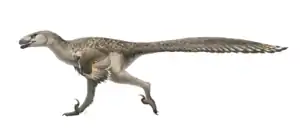
.jpg.webp)


